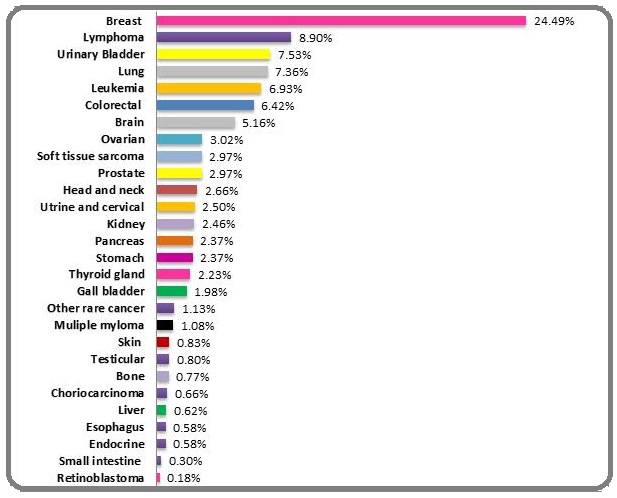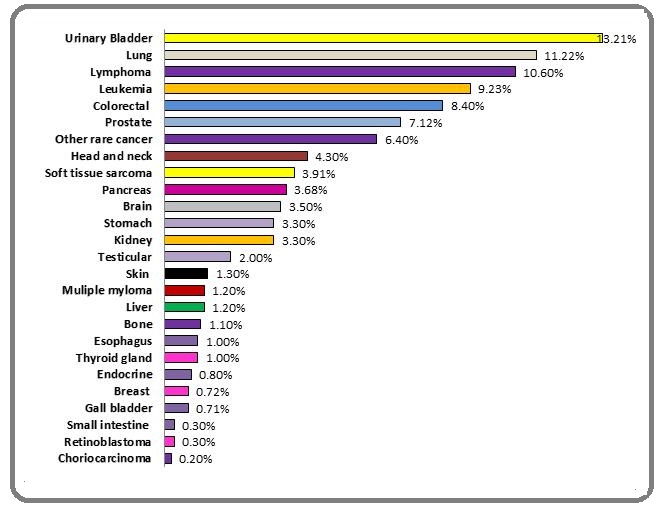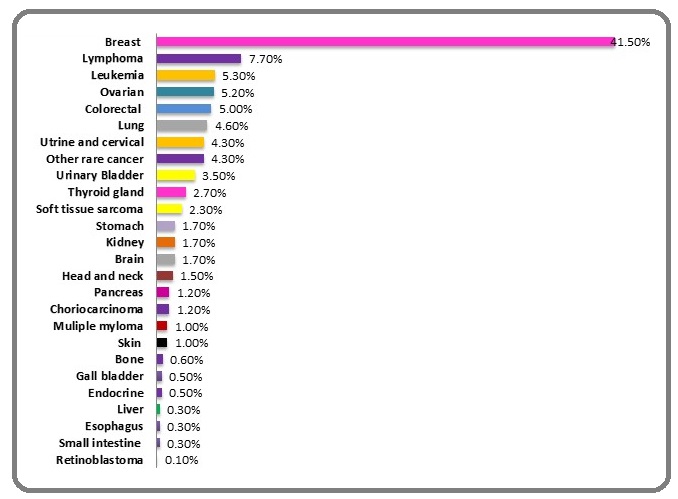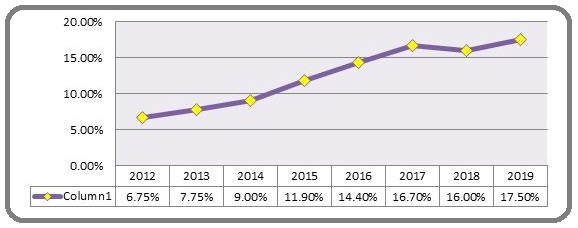Some Facts About Cancers in Karbala province of Iraq, 2012-2020
Download
Abstract
SHORT COMMUNICATION
In 2018, more than 18 million new cases of cancer occurred around the world [1]. In Iraq there are over 31,500 cases of cancer between 2017 & 2018 making it one of the country’s leading causes of death, contributing to an estimated 11% of total deaths [2]. Some experts argue that the leading cause behind cancer in Iraq is radioactive and environmental pollution due to the contamination of water, air and soil with carcinogens such as petroleum compounds [3][4]. Here we investigated cancer distribution in Al-Hussein cancer center in Karbala province of Iraq from 2012 to 2020.This center was established in November 2011 with oncology & hematology wards while health authorities in Karbala are planning for establishing radiotherapy department in future. This centre covers not only Karbala population but other patients from middle Euphrates region in Iraq are referred to this center for solid& hematological malignancy treatment [5]. There were 7468 cases were registered, male were 3117 patients (41.74%) and female were 4351 patients (58.26%), with (male to female ratio = 0.71:1). Female predominant may be explained by that our center is a referral center and many certain cancer like breast cancer refer to this center making the number of female more than male. People above 40 years old represent the majority of patients, presenting about 72.90% of cases. While those ≤ 20 years presenting about 11.40% (Table 1).
| Gender | ||
| Male n (%) | Female n (%) | |
| 0-10 | 253 (8.12) | 277 (6.37) |
| 11-20 | 164 (5.26) | 157 (3.61) |
| 21-30 | 168 (5.39) | 246 (5.65) |
| 31-40 | 238 (7.63) | 521 (11.97) |
| 41-50 | 425 (13.63) | 1060 (24.36) |
| 51-60 | 575 (18.45) | 956 (21.97) |
| 61-70 | 772 (24.77) | 799 (18.36) |
| 71-80 | 430 (13.80) | 269 (6.18) |
| 81-90 | 85 (2.73) | 60 (1.38) |
| 91-100 | 7 (0.22) | 6 (0.15) |
In general regardless of sex, breast cancer was the most common cancer registered in our center presenting about (24.49%), followed by lymphoma (8.90%), urinary bladder (7.53%), lung (7.36%), leukemia (6.93%),colorectal (6.42%), brain (5.16%), ovarian (3.02%), soft tissue sarcoma (2.97%) and prostate (2.97%) as shown in (Figure 1).
Figure 1: Incidence Rate of Cancer Types Regardless of Sex.

Top ten cancer type in males were urinary bladder (13.21%), lung (11.22%), lymphoma (10.60%), leukemia (9.23%), colorectal (8.40%), prostate (7.12%), head and neck (4.30%), soft tissue (3.91%), pancreas (3.68%) and brain (3.50%) as shown in (Figure 2) and (Table 2).
Figure 2: Incidence Rate of Cancer Types in Male.

| Male n (%) | Female n (%) | |
| 1 | Urinary bladder 411 (13.21) | Breast 1806 (41.50) |
| 2 | Lung 350 (11.22) | Lymphoma 335 (7.70) |
| 3 | Lymphoma 330 (10.60) | Leukemia 231 (5.30) |
| 4 | Leukemia 287 (9.23) | Ovarian 226 (5.20) |
| 5 | Colorectal 262 (8.40) | Colorectal 218 (5) |
| 6 | Prostate 222 (7.12) | Lung 200 (4.60) |
| 7 | Head and neck 134 (4.30) | Uterine & cervical 187 (4.30) |
| 8 | Soft tissue 122 (3.91) | Urinary bladder 152 (3.50) |
| 9 | Pancreas 115 (3.68) | Thyroid cancer 117 (2.70) |
| 10 | Brain 110 (3.50) | Soft tissue sarcoma 100 (2.30) |
| 11 | Other 774 (24.83) | Other 779 (17.90) |
| Total 3117 (100) | Total 4351 (100) |
While the top ten cancer in females were breast (41.50%), lymphoma (7.70%), leukemia (5.30%), ovarian (5.20%), colorectal (5%), lung (4.60%), uterine & cervical (4.30%), urinary bladder (3.50%), thyroid cancer (2.70%) and soft tissue sarcoma (2.30%) as shown in (Figure 3) and (Table 2).
Figure 3: Incidence Rate of Cancer Types in Female.

The number of cancer cases that registered in 2012 were 483 cases, while in 2019 more than 1200 cases were registered (Figure 4). Increase in cancer patients was steady increase not sharp increase this due to natural growing of population, increase awareness of disease and improving in diagnosis & registration. Our study may help to provide basic information to investigate epidemiological cancer characteristics, to assess progress in recent years and to develop future cancer treatment strategies.
Figure 4: Percentage of Incidence Rate of Cancer Between 2012 to 2019.

Conflicts of interest
There are no conflicts of interest.
References
- Global cancer statistics 2018: GLOBOCAN estimates of incidence and mortality worldwide for 36 cancers in 185 countries Bray Freddie, Ferlay Jacques, Soerjomataram Isabelle, Siegel Rebecca L., Torre Lindsey A., Jemal Ahmedin. CA: A Cancer Journal for Clinicians.2018;68(6). CrossRef
- WHO, Iraqi Cancer Data for 2017-2018 announcement [cited February 2020]. Available from:http://www.emro.who.int/ irq/iraq-news/cancer-data-for-20172018-announced-in-iraq. html .
- Radiation Pollution and Cancer Risks in Sulaimaniyah and Ninawa Cities, Iraq Menkhi Sadie, Shanoon Falah, Almayahi B. Annual Research & Review in Biology.2017;18(4). CrossRef
- Environmental pollutions associated to conflicts in Iraq and related health problems Al-Shammari Ahmed Majeed. Reviews on Environmental Health.2016;31(2). CrossRef
- Leukemia Epidemiology in Karbala province of Iraq Mjali Ahmed, Hasan Jaleel Al-Shammari Haider, Tawfeeq Abbas Nareen, Deheyaa Azeez Zahraa, Khudhair Abbas Saja. Asian Pacific Journal of Cancer Care.2019;4(4). CrossRef
License

This work is licensed under a Creative Commons Attribution-NonCommercial 4.0 International License.
Copyright
© Asian Pacific Journal of Cancer Care , 2020
Author Details
How to Cite
- Abstract viewed - 0 times
- PDF (FULL TEXT) downloaded - 0 times
- XML downloaded - 0 times